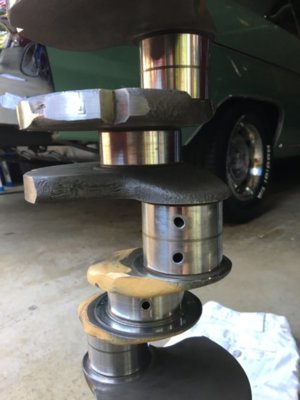Hello Folks! I'm rebuilding a 9-17-68 383 engine. It was originally installed in a 1969 Charger 383 2Bbl, so it's the advertised 9.2 to 1 compression ratio.
My Plan:
Disassemble, remove ridge, Flex hone, measure x 54 times and pray the bore measurements I get are lower than 4.2515!
I hope to thoroughly clean all pistons, install NOS Mopar rings, new Main and Rod bearings, new oil pump (standard pressure), fuel pump, 2806301 cast 4Bbl intake with Carter AVS, Aluminum Water pump and housing, new Cam and lifters, valve springs, and 1968 HP factory manifolds........... AND LET HER RIP!
* Pistons 1,5,7,and 6 have a number (casting?) 2863116 inside piston.
*Pistons 2,3,4, and 8 have number 2863115 inside piston.
I read in my 1968 parts book that there were .005" over pistons and standard size. (in addition to .020 and .040 over pistons available.
Do I have some cylinders which were .005" over from the assembly line? The part numbers in my book are 3004524 and 3004525 (.005 O/S).
Can anyone help out with a 1969 Parts book?
Also, Do any of you have experience with the Summit 6400 Camshaft?
I'm running a stoke 727, stock converter, and 3:23 gears.
Thanks for your help - it's much appreciated! (I'm sure I forgot something here)
My Plan:
Disassemble, remove ridge, Flex hone, measure x 54 times and pray the bore measurements I get are lower than 4.2515!
I hope to thoroughly clean all pistons, install NOS Mopar rings, new Main and Rod bearings, new oil pump (standard pressure), fuel pump, 2806301 cast 4Bbl intake with Carter AVS, Aluminum Water pump and housing, new Cam and lifters, valve springs, and 1968 HP factory manifolds........... AND LET HER RIP!
* Pistons 1,5,7,and 6 have a number (casting?) 2863116 inside piston.
*Pistons 2,3,4, and 8 have number 2863115 inside piston.
I read in my 1968 parts book that there were .005" over pistons and standard size. (in addition to .020 and .040 over pistons available.
Do I have some cylinders which were .005" over from the assembly line? The part numbers in my book are 3004524 and 3004525 (.005 O/S).
Can anyone help out with a 1969 Parts book?
Also, Do any of you have experience with the Summit 6400 Camshaft?
I'm running a stoke 727, stock converter, and 3:23 gears.
Thanks for your help - it's much appreciated! (I'm sure I forgot something here)

















